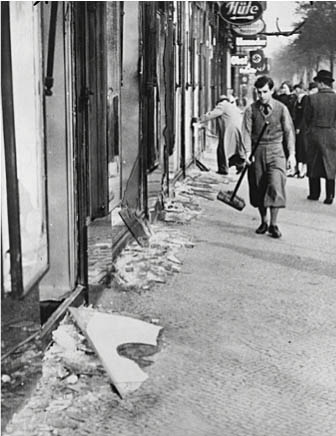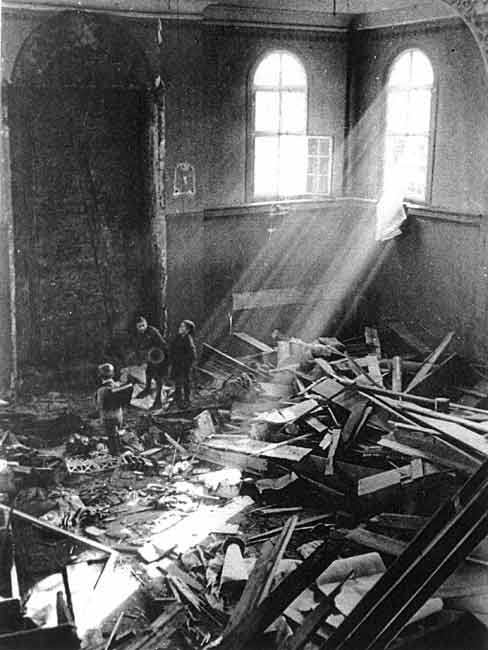KRISTALLNACHT NOVEMBER 9, 1938
from History.com

On November 9 to November 10, 1938, in an incident known as "Kristallnacht", Nazis in Germany torched synagogues, vandalized Jewish homes, schools and businesses and killed close to 100 Jews. In the aftermath of Kristallnacht, also called the "Night of Broken Glass," some 30,000 Jewish men were arrested and sent to Nazi concentration camps. German Jews had been subjected to repressive policies since 1933, when Nazi Party leader Adolf Hitler (1889-1945) became chancellor of Germany. However, prior to Kristallnacht, these Nazi policies had been primarily nonviolent. After Kristallnacht, conditions for German Jews grew increasingly worse. During World War II (1939-45), Hitler and the Nazis implemented their "Final Solution" to the "Jewish problem," and carried out the systematic murder of some 6 million European Jews in what came to be known as the Holocaust.

Hitler and Anti-Semitism
Soon after Adolph Hitler became Germany's chancellor in January 1933, he began instituting policies that isolated German Jews and subjected them to persecution. Among other things, Hitler's Nazi Party, which espoused extreme German nationalism and anti-Semitism, commanded that all Jewish businesses be boycotted and all Jews be dismissed from civil-service posts. In May 1933, the writings of Jewish and other "un-German" authors were burned in a communal ceremony at Berlin's Opera House. Within two years, German businesses were publicly announcing that they no longer serviced Jews. The Nuremberg Laws, passed in September 1935, decreed that only Aryans could be full German citizens. Furthermore, it became illegal for Aryans and Jews to marry or have extramarital intercourse.
Despite the repressive nature of these policies, through most of 1938, the harassment of Jews was primarily nonviolent. However, on the night of November 9, all that changed dramatically.
From Harassment to Violence
In the fall of 1938, Herschel Grynszpan (1921-45), a 17-year-old ethnically Polish Jew who had been living in France for several years, learned that the Nazis had exiled his parents to Poland from Hanover, Germany, where Herschel had been born and his family had lived for years. As retaliation, on November 7, 1938, the agitated teenager shot Ernst vom Rath (1909-38), a German diplomat in Paris. Rath died two days later from his wounds, and Hitler attended his funeral. Joseph Goebbels (1897-1945), the Nazi minister for public enlightenment and propaganda, immediately seized on the assassination to rile Hitler's supporters into an anti-Semitic frenzy.
Kristallnacht was the result of that rage. Starting in the late hours of November 9 and continuing into the next day, Nazi mobs torched or otherwise vandalized hundreds of synagogues throughout Germany and damaged, if not completely destroyed, thousands of Jewish homes, schools, businesses, hospitals and cemeteries. Nearly 100 Jews were murdered during the violence. Nazi officials ordered German police officers and firemen to do nothing as the riots raged and buildings burned, although firefighters were allowed to extinguish blazes that threatened Aryan-owned property.
In the immediate aftermath of Kristallnacht, the streets of Jewish communities were littered with broken glass from vandalized buildings, giving rise to the name Night of Broken Glass. The Nazis held the German-Jewish community responsible for the damage and imposed a collective fine of $400 million (in 1938 rates), according to the U.S. Holocaust Memorial Museum. Additionally, more than 30,000 Jewish men were arrested and sent to the Dachau, Buchenwald and Sachsenhausen concentration camps in Germany — camps that were specifically constructed to hold Jews, political prisoners and other perceived enemies of the Nazi state.
U.S. Reaction to Kristallnacht
On November 15, 1938, Franklin D. Roosevelt (1882-1945), the American president, responded to Kristallnacht by reading a statement to the media in which he harshly denounced the rising tide of anti-Semitism and violence in Germany. He also recalled Hugh Wilson, his ambassador to Germany.
Despite Roosevelt's condemnation of the Nazi violence, the U.S. refused to ease the immigration restrictions it then had in place, constraints that prevented masses of German Jews from seeking safety in America. One reason was anxiety over the possibility that Nazi infiltrators would be encouraged to legally settle in the U.S. A more obscured reason was the anti-Semitic views held by various upper-echelon officials in the U.S. State Department. One such administrator was Breckinridge Long (1881-1958), who was responsible for carrying out policies relating to immigration. Long took an obstructionist role in granting visas to European Jews, and maintained this policy even when America entered World War II after the December 7, 1941, Japanese attack on Pearl Harbor, Hawaii.
A Wake-up Call to German Jews
The violence of Kristallnacht served notice to German Jews that Nazi anti-Semitism was not a temporary predicament and would only intensify. As a result, many Jews began to plan an escape from their native land.
Arthur Spanier (1899-1944) and Albert Lewkowitz (1883-1954) were two who wanted to come to the U.S.; however, their task was not a simple one. Spanier had been the Hebraica librarian at the Prussian State Library and an instructor at the Hochschule für die Wissenschaft des Judentums (Higher Institute for Jewish Studies), both located in Berlin, Germany. After Kristallnacht, he was sent to a concentration camp, but was released upon receiving a job offer from the Cincinnati, Ohio-based Hebrew Union College. Spanier applied for an American visa, but none was forthcoming. Julian Morgenstern (1881-1976), president of the college, traveled to Washington, D.C., for an explanation. Morgenstern was told that Spanier was denied the visa because he was a librarian and, according to U.S. State Department rules, a visa could not be issued to an academic in a secondary educational position even if a major American educational institution had pledged to support him.
Lewkowitz, a philosophy professor at the Breslau Jewish Theological Seminary, was granted a visa. He and Spanier traveled to Rotterdam, the Netherlands, but were trapped there when the Germans invaded in May 1940. Lewkowitz's visa was destroyed as the Germans bombarded the city. Bureaucrats at the American consulate suggested that he acquire another visa from Germany. Given the circumstances, this would be impossible. Both men soon found themselves in the Bergen-Belsen concentration camp. Spanier lost his life there, while Lewkowitz was released in 1944 during a prisoner exchange. That year, he settled in Palestine.
A Wake-up Call to Non-Jews
Not all those who were impacted by Kristallnacht were practicing Jews. Edith Stein (1891-1942), a German philosopher and nun, was born a Jew but converted to Catholicism. In 1933, she was accepted as an initiate at the Carmelite convent in Cologne, Germany, and took the name Teresa Benedicta a Cruce. She was joined there by her older sister Rosa, who had also become a Catholic.
After Kristallnacht, the Steins left Germany and resettled in a Carmelite convent in Echt, the Netherlands. In 1942, as the Germans began deporting Jews from the Netherlands, Edith Stein successfully applied for a visa that would allow her to move to a convent in neutral Switzerland. However, Rosa was unable to obtain a visa and Edith declined to leave the Netherlands without her.
In August 1942, the Nazis arrested both women and dispatched them to a concentration camp at Amersfoort, the Netherlands. Shortly afterward, they were sent to the Auschwitz-Birkenau death camp where they perished in a gas chamber. In 1987, Edith Stein was beatified as a Catholic martyr by Pope John Paul II (1920-2005).
Conditions Worsen after Kristallnacht
Kristallnacht marked a turning point toward more violent and repressive treatment of Jews by the Nazis. By the end of 1938, Jews were prohibited from schools and most public places in Germany — and conditions only worsened from there. During World War II, Hitler and the Nazis implemented their "Final Solution" to the "Jewish problem," and carried out the systematic murder of some 6 million European Jews (along with, by some estimates, 4 million to 6 million non-Jews) in what came to be known as the Holocaust.
As for Herschel Grynszpan, whose shooting of a German diplomat was used as an excuse by the Nazis to perpetrate the Kristallnacht violence, his fate remains a mystery. What is known is that he was incarcerated in a Paris prison and later transferred to Germany. According to some accounts, Grynzpan was eventually executed by the Nazis. However, other sources claim he survived the war and resettled in Paris, where he married and started a family under an assumed name.
The www.History.com website has lists of historic events and articles on a wide range of historical topics. The photos come from www.eiutps.blogspot.com.